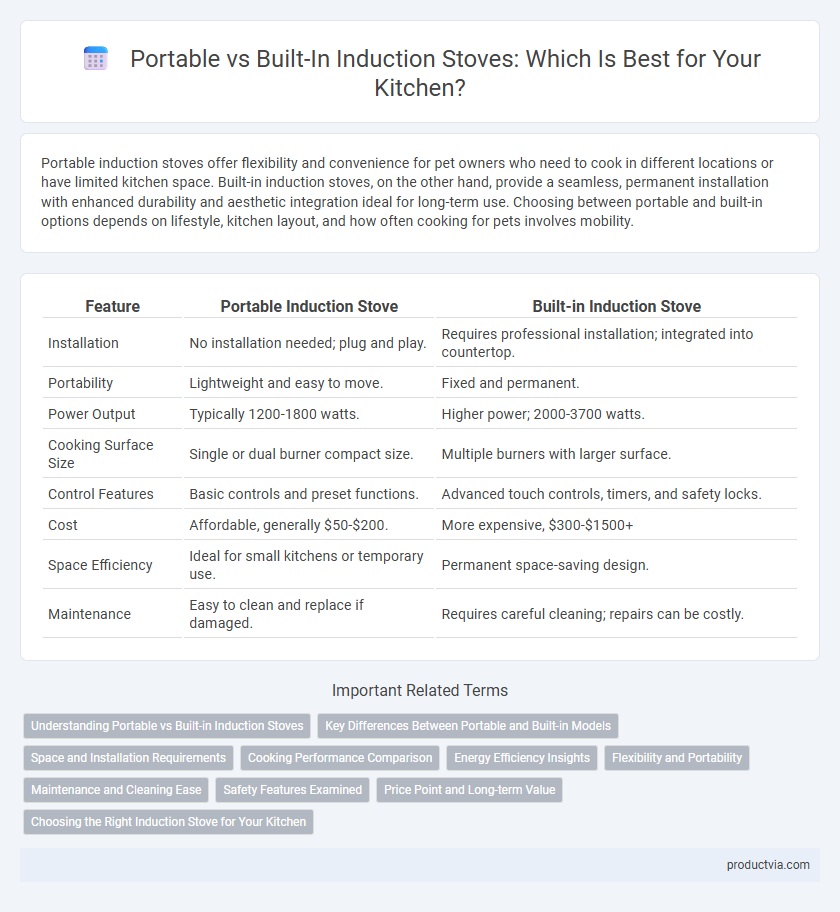Portable induction stoves offer flexibility and convenience for pet owners who need to cook in different locations or have limited kitchen space. Built-in induction stoves, on the other hand, provide a seamless, permanent installation with enhanced durability and aesthetic integration ideal for long-term use. Choosing between portable and built-in options depends on lifestyle, kitchen layout, and how often cooking for pets involves mobility.
Table of Comparison
| Feature | Portable Induction Stove | Built-in Induction Stove |
|---|---|---|
| Installation | No installation needed; plug and play. | Requires professional installation; integrated into countertop. |
| Portability | Lightweight and easy to move. | Fixed and permanent. |
| Power Output | Typically 1200-1800 watts. | Higher power; 2000-3700 watts. |
| Cooking Surface Size | Single or dual burner compact size. | Multiple burners with larger surface. |
| Control Features | Basic controls and preset functions. | Advanced touch controls, timers, and safety locks. |
| Cost | Affordable, generally $50-$200. | More expensive, $300-$1500+ |
| Space Efficiency | Ideal for small kitchens or temporary use. | Permanent space-saving design. |
| Maintenance | Easy to clean and replace if damaged. | Requires careful cleaning; repairs can be costly. |
Understanding Portable vs Built-in Induction Stoves
Portable induction stoves offer flexibility and easy storage, ideal for small kitchens or outdoor cooking, while built-in induction stoves provide a seamless, permanent installation with a sleek countertop design and enhanced cooking zones. Portable units typically feature fewer burners and lower wattage, suitable for casual cooking needs, whereas built-in models support multiple high-power burners with precise temperature controls for advanced culinary tasks. Choosing between these depends on space availability, usage frequency, and desired kitchen aesthetics.
Key Differences Between Portable and Built-in Models
Portable induction stoves offer flexibility with compact, lightweight designs ideal for small kitchens or travel, while built-in models provide a seamless, integrated look with enhanced power and multiple cooking zones for more extensive use. Portable units typically have lower wattage and single burner options, making them energy-efficient for limited cooking needs, whereas built-in induction cooktops support higher wattage and multiple burners, catering to varied cooking tasks simultaneously. Installation differs significantly; portable stoves require no permanent setup, whereas built-in induction hobs necessitate professional installation within countertops for a flush, streamlined appearance.
Space and Installation Requirements
Portable induction stoves offer compact designs ideal for limited kitchen spaces, requiring minimal installation as they simply plug into standard outlets. Built-in induction stoves demand precise countertop cutouts and professional installation, occupying a fixed space integrated with kitchen cabinetry. Choosing between the two depends on available kitchen space and willingness to undertake installation complexity, with portable units providing flexibility and built-in models offering a seamless, permanent setup.
Cooking Performance Comparison
Portable induction stoves offer flexibility with quick heat adjustments and consistent temperature control, making them suitable for diverse cooking tasks. Built-in induction stoves provide more powerful heating elements and larger cooking surfaces, enabling faster boil times and support for multiple pots simultaneously. Both types ensure precise cooking performance, but built-in models excel in scalability for high-volume or multi-dish preparation.
Energy Efficiency Insights
Portable induction stoves typically consume less energy due to their smaller size and focused heating area, making them highly efficient for single or small meal preparations. Built-in induction stoves offer superior energy efficiency benefits in larger kitchens by providing consistent heat distribution and advanced temperature control features. Energy efficiency in induction stoves is primarily measured by their ability to convert electricity directly into heat with minimal loss, which both styles achieve but differ based on usage scale and installation.
Flexibility and Portability
Portable induction stoves offer unmatched flexibility, allowing users to cook anywhere with easy storage and transport options. Built-in induction stoves provide a sleek, permanent installation that maximizes kitchen space but lack portability. Choosing between the two depends on lifestyle needs, with portable models favored for versatility and built-in units for a streamlined, stationary kitchen setup.
Maintenance and Cleaning Ease
Portable induction stoves offer straightforward maintenance with compact, detachable surfaces that are easy to clean after each use, making them ideal for quick cleanup. Built-in induction stoves, integrated into countertops, often require specialized cleaning tools and care to maintain seamless surfaces and prevent damage to the installation. Both types benefit from smooth glass-ceramic tops that resist spills and stains, but portable models provide more flexibility in thorough cleaning access.
Safety Features Examined
Portable induction stoves typically include advanced safety features such as automatic shut-off, child-lock mechanisms, and overheat protection to prevent accidents during use. Built-in induction cooktops offer integrated safety systems like pan detection and residual heat indicators, enhancing kitchen safety by ensuring the surface cools quickly after cooking. Both types prioritize user safety but vary in their specific mechanisms and installation-related risks.
Price Point and Long-term Value
Portable induction stoves generally have a lower price point, making them ideal for budget-conscious consumers or those needing a flexible cooking solution. Built-in units typically demand a higher initial investment but offer greater durability and seamless integration, enhancing long-term value through improved kitchen aesthetics and consistent performance. Considering energy efficiency and maintenance costs, built-in induction stoves often provide better returns over time despite the higher upfront expense.
Choosing the Right Induction Stove for Your Kitchen
Portable induction stoves offer flexibility and space-saving benefits, ideal for small kitchens or for use as an additional cooking surface. Built-in induction stoves provide a sleek, integrated look with more cooking zones and advanced features suited for permanent kitchen installations. Selecting between portable and built-in models depends on cooking needs, kitchen size, and installation preferences to optimize convenience and functionality.
Portable vs built-in for induction stove Infographic

 productvia.com
productvia.com